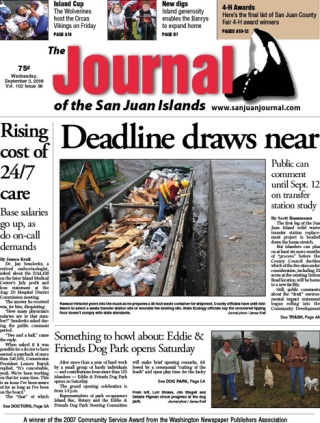The first leg of the San Juan Island solid waste transfer station replacement project is headed down the home stretch.
But islanders can plan on at least six more months of “process” before the County Council decides which of the five sites under consideration, including 33 acres at the existing Sutton Road location, will be home to a new facility.
Still, public comments about the “draft” environmental impact statement began rolling into the Community Development and Planning Department early last week. The weighty 266-page document identifies impacts which are likely to occur at each of the five sites and surrounding neighborhoods if a transfer station with a life-span of at least 20 years is built there.
As of Friday, CDPD had nearly a dozen comments on file and more are expected, according to Senior Planner Shannon Fitzgerald. All comments generated by the draft Environmental Impact Statement, or DEIS, are reviewed and responded to as part of the final environmental impact statement.
A public hearing on the draft is slated for Sept. 11 and the deadline for public comments is Sept. 12.
About 30 islanders perused maps, displays and information set out during the second of two informational meetings on the draft document Thursday at the San Juan Island Fire Department headquarters on Mullis Street. County staff and the team of consultants that authored the DEIS answered questions about the project as well.
According to John Davies of Kirkland-based Mirai group, an associate of AMEC, lead consultant of the project, concerns over potential dangers of increased traffic and the safety of bicyclists are a recurring theme. But concerns over traffic are typical when large-scale public projects are proposed, Davies said, and often outweigh in number the those raised about noise or wetland impacts.
“Nine times out of 10, traffic is an issue,” he said. “There aren’t that many people with the expertise to know how a wetland might be impacted by a project but everyone is an expert when it comes to traffic.”
Whether it’s traffic, wetlands, noise, litter or the potential of disease-carrying rodents, Gary Harshman of AMEC maintains that the impacts or obstacles at any of the five sites can be remedied.
“There’s no deal breakers,” Harshman said. “I think all the major issues at any of the sites are mitigateable.”
Harshman said his team of consultants will be helping the Solid Waste Advisory Group to develop a criteria in the following weeks for comparing the sites and selecting its preferred location. But the DEIS nor final EIS will rank the sites in order of greatest to lowest impacts or in preference.
“That’s best left up to the decision makers,” he said.
Meanwhile, pressure continues to mount the county Public Works department and its solid-waste operation on Sutton Road. Its request for a two-year extension on a state-approved variance, which allows garbage to be dumped onto a tipping floor without a cover and which remains open to the elements, was rejected recently by the state Department of Ecology.
In response to Public Works’ request, Ecology’s Peter Christiansen, section manager of DOE’s solid waste and financial assistance program, set down a series of conditions that must be met before the department would consider extending the variance beyond its mid-March deadline. Those conditions include:
— Controls remain in place effect to continue to effectively manage runoff and litter.
— Final EIS is completed and approved in January 2009.
— Site selection completed by February 2009.
— Funds are committed to design and construct the new facility by February 2009.
“If the (County Council) does not intend to replace the transfer station, the existing transfer station would be required to shut down unless modifications were made to it,” Christiansen said in the letter.
In addition, Ecology will require a “firm schedule” for design and construction of a new facility before another extension would be considered.




